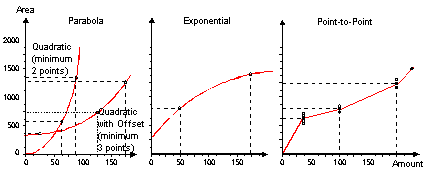Theory of Calibration
![]() Calibration Types (Non-linear)
Calibration Types (Non-linear)
Non-linear calibration is more general. In this case, more terms are added to the linear Calibration Function.
Quadratic Function
In Chromeleon, the calibration type Quadratic (Quad, QOff) is provided for this function.
Parabola-shaped curves are described as follows:
![]() (Quadratic)
(Quadratic)
![]() (Quadratic with offset)
(Quadratic with offset)
Cubic Function
In Chromeleon, the calibration type Cubic (Cubic, COff) is provided for this function.
In some cases, especially in gas chromatography, there is cubic relationship:
![]() (Cubic)
(Cubic)
![]() (Cubic with offset)
(Cubic with offset)
To calculate curves of this type, a minimum of two (quadratic), three (quadratic with offset or cubic), or four (cubic with offset) calibration samples must be available (for the quadratic relationship, see the leftmost picture).

![]() Notes on Standard Addition calibration mode:
Notes on Standard Addition calibration mode:
If you calibrate using the Standard Addition method and if no calibration points with Amount = 0 are available (Spiked samples only), Chromeleon also calibrates with an offset when the Quadratic or Cubic calibration method is used.
If calibration points with Amount = 0 are available (Unspiked samples, also) and if you calibrate using the Quadratic or Cubic calibration method, the calibration curve does not go through the origin. Instead, it is forced through the mean of all samples for which Amount = 0; i.e., all unspiked samples for this substance. Please note that the results may be different from those obtained by calibrating with the Quadratic with Offset or Cubic with Offset calibration method.
Power Function
In Chromeleon, the Exponential (Exp) calibration type is used to describe a power function.
It is described as follows:
![]()
To calculate curves of this type, a minimum of two calibration points must be available (see the image in the center).
Chromeleon computes the logarithm of the coordinates and then applies linear least square fitting. Therefore, this calibration type is also referred to as Log-Log Linear.

Due to this, we recommend:
Using this calibration plot only to quantitate values within the minimum and maximum calibration limits.
Preparing standards at logarithmic intervals so that they are given equal weighting when calculating the best fit.
![]() Notes on Standard Addition calibration mode:
Notes on Standard Addition calibration mode:
If you calibrate using the Standard Addition method and if you use the Exponential calibration function, the expected offset value is subtracted from all calibration points with positive amount values (i.e., from all Spiked Samples). Thus, the following formula applies:
![]()
Distinguish between the following cases:
a) If no calibration points with Amount = 0 are available (Spiked samples only), the expected offset is calculated using the Linear with Offset method, i.e.:
![]()
b) If calibration points with Amount = 0 are available (Unspiked samples, also), the expected offset is the average of all samples with Amount = 0.
Point-to-Point
If none of the above functions can be applied to the available Calibration Points, the calibration curve can be described as a polygon, i.e., a linear interpolation between two adjacent calibration points (Point to Point). If several replicates of one calibration level are available, these are averaged before interpolation.
![]() Caution:
Caution:
The decision whether it is physically sensible to use a calibration type other than the default linear is the responsibility of the user. (With a calibration type that is physically not sensible, no y values may appear for the actually measured values. For example, if, for the Quadratic calibration type, the calibration function is a bottom-down parabola-shaped curve, the values measured above the summit cannot be evaluated. In this case, Chromeleon reports "n.a.")
A large number of replicates increases the precision and the reliability of the curve at this point (on the calibration level), but is not decisive for the entire curve. The more calibration levels are examined, i.e., the more standards of different concentrations are measured, and the more precise is the area/amount allocation for a larger range. To be exact, the calibration is valid only for the range of the calibration samples and not beyond it.